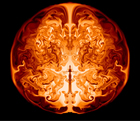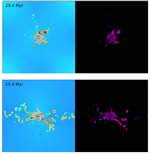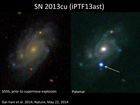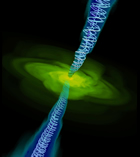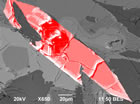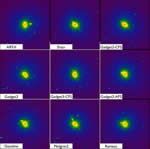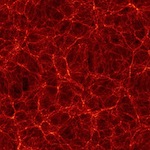Word doc
PDF (formatted and ready to go as a single newsletter page)
HAWC-Eye on the Sky
The most violent phenomena in the Universe—blazars and gamma-ray bursts—are in the sights of a brand new wide-field telescope that began monitoring the heavens high in the mountains of Mexico on August 1, 2013.
Called the High-Altitude Water Cherenkov (HAWC) Observatory, the brand new instrument will observe gamma rays (the Universe’s most energetic photons) and high energy cosmic rays (protons and nuclei with energies higher than 100 billion electron volts, or 100 GeV).
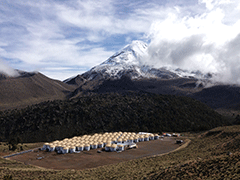
Array of 115 water tanks of the High-Altitude Water Cherenkov (HAWC) Observatory as it appeared on September 13, 2013. When completed in early 2014, it will have 300 tanks. HAWC is at an altitude of 4,100 meters on the flanks of the Sierra Negra volcano near Puebla, Mexico. It is an international collaboration of over 20 institutions in the U.S. and Mexico. In the background is Pico d’Orizaba, a dormant volcano with an elevation of 5,635 meters (the highest peak in North America outside of Alaska). Credit: Benemérita Universidad Autónoma de Puebla
"At these energies, photons behave more like particles than waves," he continued. "Looking at the cosmos at such extraordinarily high energies filters out normal stars and galaxies, letting us see only the most extreme objects imaginable." Blazars are active galactic nuclei—supermassive black holes a million times more massive than the sun that generate intense radiation as material falls into them—with jets pointed at us. Gamma-ray bursts originate from a class of supernovae (exploding stars) with jets pointed at us, or from merging neutron stars.
A telescope made of water
Extraordinary energies call for extraordinary detectors—and HAWC looks like no ordinary telescope. For one thing, it does not form an image, so there are no lenses or mirrors. Instead, the instrument consists of an array of gigantic corrugated steel tanks—each 4.5 meters deep and 7.3 meters across—filled with ultrapure water. At the bottom of each tank are four photomultiplier tubes sensitive to ultraviolet light, one in the center and three more in an equilateral triangle around it.
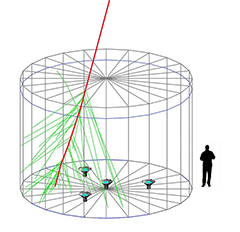
Each corrugated steel tank in HAWC is 7.3 meters across and 4.5 meters deep. It contains a bladder filled with ultrapure water. At the base are four photomultiplier tubes. This diagram shows a charged particle (red line) passing through a tank and emitting Cherenkov radiation (green lines). Credit: Image created by Brian Baughman of the University of Maryland and Segev Benzvi of the University of Wisconsin using the GEANT4 detector simulation code.
What can be learned
Timing the order in which the photomultiplier tubes detect the Cherenkov radiation to less than a nanosecond reveals essential astronomical data. For example, gamma rays tend to produce flashes of light that are brightest near the center of a particle shower and decrease in intensity radially, whereas cosmic ray air showers tend to create a messy or blotchy “footprint.” And although HAWC observes the entire sky 24/7 and there is no steering or pointing mechanism, it is possible to determine the direction from which a pancake of particles came to within an angular accuracy as fine as 0.2 degree (about half the diameter of the full moon).
HAWC’s wide field of view and continuous operation are essential to capture rare, short duration phenomena such as gamma-ray bursts. When all the tanks are completed in 2014, HAWC will detect 20,000 cosmic ray air showers each second, which requires recording 500 megabytes of data each second. HAWC runs continuously, so data are calibrated, reconstructed, and analyzed in real time by a farm of computers at the remote, high-altitude site, sending out prompt alerts to astronomers observing at other wavelengths worldwide in the event of a transient.
Why and how do astronomical objects emit such energetic radiation and particles? Replied Sinnis: “This is a great question and one we are seeking to answer!”
–Trudy E. Bell, M.A.
Further reading: Construction and operation details about HAWC appear at the HAWC website at http://www.hawc-observatory.org/ and the sensitivity is described in a soon to be published paper arXiv:1306.5800.
The University of California High-Performance AstroComputing Center (UC-HIPACC), based at the University of California, Santa Cruz, is a consortium of nine University of California campuses and three Department of Energy laboratories (Lawrence Berkeley Laboratory, Lawrence Livermore Laboratory, and Los Alamos National Laboratory). UC-HiPACC fosters collaborations among researchers at the various sites by offering travel and other grants, co-sponsoring conferences, and drawing attention to the world-class resources for computational astronomy within the University of California system. More information appears at http://hipacc.ucsc.edu .


